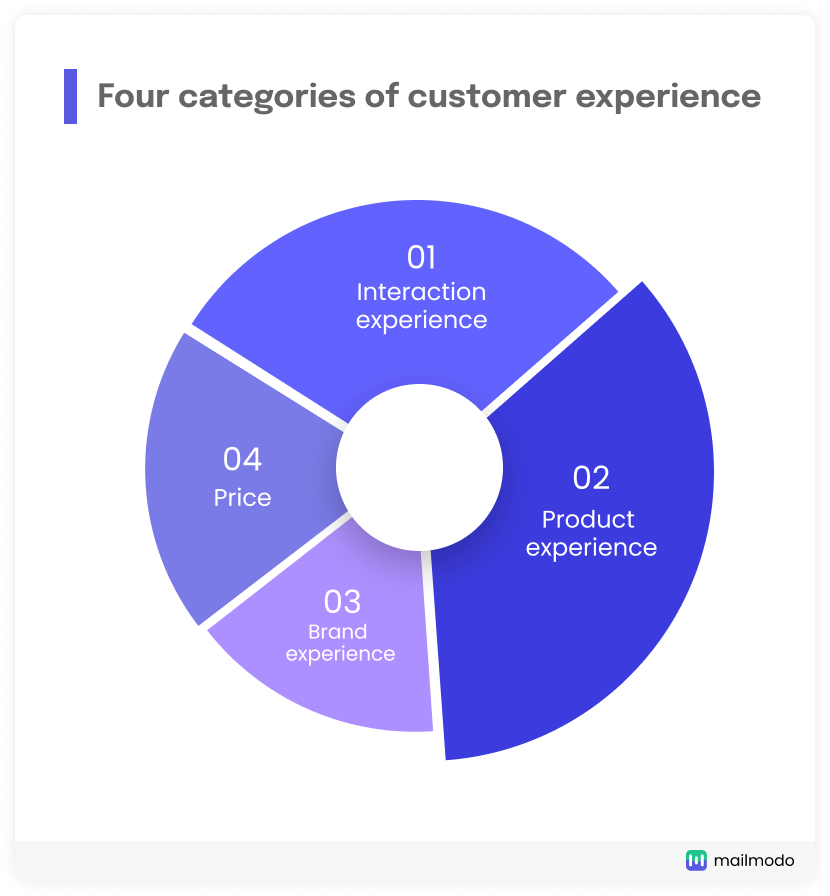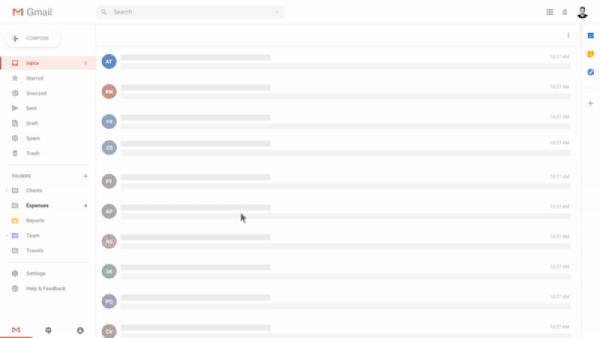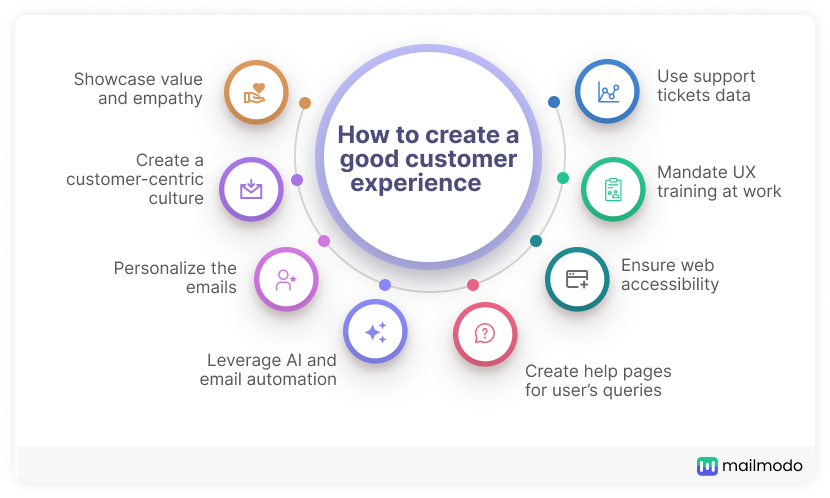The digital marketplace has seen a massive shift in online shoppers as more people shift to the internet. In the virtual world, the essence of developing and nurturing direct connections with customers has become more important than ever.
All this can only be done by creating an exceptional customer experience (CX). But, it's easier said than done as CX goes beyond providing fast, friendly services.
In this guide, we discuss CX in much more detail. So, hop on with us on this intriguing CX journey.
Table of contents
- What is customer experience?
- What is customer experience management?
- Customer service vs. customer experience
- Why is CX important for your business?
- What makes a good user experience?
- How to identify areas to improve CX
- Step 1: Map different touchpoints of the customer's journey
- Step 2: Collect feedback at each touchpoint
- How to measure and analyze the data
- How to create a good customer experience
- Key takeaways
What is customer experience?
The customer experience (CX) is the sum of all the interactions a customer has with your brand throughout their buyer's journey. CX symbolizes the relationship between a brand and its Ideal Customer Profile (ICP).
No matter how brief or long, every interaction impacts how customers feel and perceive your brand. Whether it's signing up for your weekly newsletter, talking to your sales team, using your product/services, or raising a ticket, every exchange influences how users think and decide about your brand and product.
What is customer experience management?
Customer experience management (CXM or CEM) takes a holistic approach to improve user experience.
It is a system to track, organize, analyze, and optimize user interactions throughout the user's lifecycle.
As per a Gartner research, CX can be divided into four primary categories:

Interaction experience — what the company does and how customers evaluate their interaction based on considerations such as ease of use, convenience, personalization, and uniqueness.
Product experience — what the product does and reflects users' experience with the product/service. This includes product utility, usability, customer needs alignment, and life enrichment.
Brand perception reflects customers' view of the company's authority and position in its industry and how well it aligns with its values.
Price is the user's estimation of whether the product offers good value for money.
These four categories represent the customer's evaluation of the companies before buying. Hence, managing user's perception in these categories is essential to offer a great CX.
Customer service vs. customer experience
Simply put, customer service is only a part of the customer experience.
Customer experience is a customer's overall perception of your brand based on its interaction at various touchpoints. In contrast, customer service is one of those touchpoints that come into play when users need help.
For example, getting on a call with customer support to raise a bug or issue via email.
Why is CX important for your business?
As per Zendesk's CX Trends report 2021, 63% of CX managers say their company prioritized CX more than a year ago. Undoubtedly, the companies are going crazy over CX as it impacts user retention, LTV, and loyalty.
• Increases customer retention leading to higher LTV
Investing in CX impacts how customers make buying decisions. Product experience is the most influential in improving customer retention. Suppose customers feel that your product improves their lives and gets work done; they are more likely to become repeat customers.
By investing in building a better UX, you can see a 60% increase in customer LV.
Related guide: How to Increase Your Customer Lifetime Value Using Email Marketing
• Builds brand loyalty
76% of consumers are likely to recommend a brand because of its simpler experiences and communications.
Better yet, satisfied customers become advocates of a brand as they promote and spread the word about the company's quality services. Loyalty triggers when users feel confident that they've made the right choice.
• Help your brand stand out among competitors
Creating a seamless experience for users at each touchpoint drives competitive advantage. Your customers are only a click away from ditching your brand and moving to your rivals. Half of the customers would switch over to a competitor if they had one bad experience with your brand.
By implementing an effective CX strategy, you can instantly create a seamless experience for the users and resolve their queries. The better you listen to their needs and offer solutions, the more they'll return to your brand.
What makes a good user experience?
We've seen that when we focus on the consumer experience first and define what that is and the experience we want them to have with our brand, we're able to determine which channels best deliver that experience. - Kevin George
Here are the 5 basics of a good customer experience:
Frictionless - Cut any obstacle that might hinder researching, buying, and interacting. A frictionless experience can include clear navigation, easy signup, and a checkout process.
Personalized - Make every user feel unique by offering personalized content such as product recommendations emails.
Fast - Make sure your digital assets, like landing pages, emails, and website, load within seconds.
Helpful - Offer relevant and helpful content at each stage in the user's buying journey.
Consistent - Make shopping and discovery consistent by allowing users to pick up where they left off earlier instead of making them repeat the same process.
Now, the question arises: How do you create a good customer experience? Well, it all begins with putting yourself in your audience's shoes and collecting feedback.
How to identify areas to improve CX
You need to follow these two steps to identify areas for improvement:
Step 1: Map different touchpoints of the customer's journey
Your target audience consists of different buyers' personalities, and it's impossible to create a single experience that meets the needs of all of them. That is why you need to identify different touchpoints or micro-moments they go through. The gap between customer expectations and experience at each touchpoint spells the difference between customer delight and something less.
You need to be laser-focused while identifying these touchpoints because randomized touchpoints won't help you make optimization. Each touchpoint requires special attention and different marketing tactic to maintain a seamless customer experience:
New users signup for an email newsletter
Cart abandonment
Free trial users
Users booked a demo
User raised a complaint
You can read how to map a customer's journey to analyze various touchpoints.
Step 2: Collect feedback at each touchpoint
Choose customers from each target persona and collect feedback from them. You can easily identify the major user experience issue through this small sample. Now, you need to collect both quantitative and qualitative feedback.
To collect qualitative feedback, you use the following methods:
Engage in community forums and figure out problems users might have with your brand or with a competitor's brand and how you can use this information.
Use customer service data and analyze issues for which you've got the most complaints and tickets raised.
Talk to your sales team and get insights into product-related issues as they directly communicate with your prospects.
Use the following method to collect quantitative feedback:
1. Use customer experience surveys
Customer Satisfaction (CSAT) score - To learn the user's satisfaction with your product/service.
Net Promoter Score (NPS) - Reveals how likely a user is to recommend your company/product to others on a scale of 0-10. NPS surveys can be insightful for improving CX, and combining them with the AMP framework can increase the submission rate by 45%.
Here's how our AMP NPS survey works:

Check out our NPS Survey Email template
Customer Effort Score (CES): Measures how easily users get things done, like fixing a problem through customer support.
Point-of-conversion survey: Ask to rate their buying experience on a scale (from 1 'hated it' to 5 'loved it'), including follow-up questions.
Retention survey: why users' are downgrading/canceling service or why they are returning an item.
2. Use polls
Polls are fun and interactive ways to collect feedback. You can use social media and emails and embed them on your website. Being one of the most widely used channels, sending polls in the email can help you collect valuable feedback. You can customize the form based on buyer persona and get a higher response.
Twitterati love polls, don't you?
— Aquibur Rahman (@AR_Bits) August 25, 2021
But, now you can add a poll inside the email with @mailmodo and engage your users more. They will also be able to see results in real-time. pic.twitter.com/PTnD4mf58A
3. Monitor users' on-site behavior
Monitor how and where users drop off during their interaction with your brand using heatmap and marketing analytics tools.
Related guide: How To Use Heatmaps to Analyze Your Website Performance
How to measure and analyze the data
Once you have the data, the CX team needs to assess this. They must focus on issues that impact the majority of the users and business KPIs.
Identify different touchpoints where users most often drop off.
What is the most common issue that most of the users raise?
Is there any issue emerging from your brand's policy?
Is there any issue from a failure on the part of your employees?
You'll need software to assess the issues and develop strategies to improve CX. Some of them include:
Customer data platforms (CDP) like Tealium.
Customer relationship management (CRM) like Hubspot, and
Website analytics tools like Google Analytics.
How to create a good customer experience

There are several ways to enhance user experience, and what works for others might not work for you. But, there are still some standards you should implement to create a good CX, and some of them are discussed below:
1. Showcase your value and empathy
You need to go beyond the basics and align your brand with your values and ethics. In a socially competing environment, users tend to buy from brands that showcase their values and lead with them. And as the world is becoming more adaptive to new norms and cultures, you need to showcase how your brand fits in with such changes. And even research shows that 54% want to buy from companies that prioritize diversity, equity, and inclusion in their communities and workplaces.
2. Create a customer-centric culture in your organization
Creating a culture where the organization works towards improving the CX is integral to a healthy and positive customer relationship. It begins with building trust and value among your users.
Your customers want to feel like they're treated as human beings and not as some sort of transaction. To make them feel that your CX team needs to put themselves in the user's shoes and go on from there.
3. Create a personalized email experience
If users have signed up for your emails, you've got one of the biggest leverage to enhance customer experience. You can deliver personalized, interactive emails to users throughout the user's life cycle.
For instance, use onboarding emails to welcome and familiarize users with your brand and product. And by adding interactivity using AMP email, you can create a frictionless experience for your users. With Mailmood's integration with Segment, you can create personalized emails and send them to your segment database without much hassle.
4. Leverage AI and automated email flows
To meet and exceed customers' expectations, you need to create a series of different touchpoints to reach and engage with them. That's where Artificial intelligence (AI) and automated email flows can be your ally.
AI, such as chatbots, can offer real-time and instant solutions to users' queries.
An automated email series will also help you nurture relationships by targeting users with the right email at the right time. Besides, you can make the whole experience more humanized by personalizing email content.
5. Create help pages to resolve user's queries
Sometimes users might want to resolve any query independently rather than talking to a virtual assistant. In such cases, you can create a help section to assist users. Ensure that the help section should be easy to locate, and the content should be easy to understand. Also, add a section where users can raise an issue if they can't find the answer to their queries.
6. Ensure web accessibility
A good customer experience is inclusive and accessible to everyone despite their disability like visual impairment, color blindness, or dementia. Since these people use assistive technologies like screen readers and hearing aids, you need to ensure every element on your website is accessible and easy to understand.
Here are a few recommendations to make the web experience accessible:
Enabling keyboard-based navigation for customers who use assistive technology
Prominent and bigger CTA button.
Color contrast should be at least 4.5:1
Make customer service options prominent and easy to understand, and the list goes on.
7. Mandate user experience training at work
Lack of employee knowledge and training is the biggest obstacle that keeps companies from reaching their CX goals. So, it's imperative to foster a user-centric culture and build on the foundation of serving the customers as best as possible.
Conduct training and workshops to equip employees with information on handling users' queries and streamlining workflow across different channels. Besides, employees in different departments should share their insights and feedback so that the CX team can develop a more user-centric strategy.
8. Mine data from support tickets & chat logs
Using a customer support ticketing system like Zendesk, you capture information about your customers and their experience with your company and products. Mining the data within your support tickets and chat logs will help you spot issues and opportunities for improvement.
For instance, one major issue raised by users was confusing analytics UI. If your sales team worked on the issue and made it better as per the user's preference, you can send a product update email to let users know. And you can even integrate your Zendeska account with Mailmodo and reach out to users who raised the issue directly.
Key takeaways
It's not magic. It's not science. It is simply building a tighter relationship with your customer. Eric Carlson - Founder, 10XFactory
And with that, we would like to share major key takeaways from our guide:
- A good customer experience is closely tied to custom retention, loyalty, and lifetime value. The better you serve them, the better they'll become a fan of your brand.
- Nurture relationships with your users at each touchpoint and establish your brand as a go-to provider.
- Use email marketing to send contextual and relevant personalized emails and make users a part of your brand rather than just a sale.
- Continuously iterate your CX practices by analyzing users' feedback and bridging the gap between their expectations and your service.
What you should do next
Hey there, thanks for reading till the end. Here are 3 ways we can help you grow your business:
Talk to an email expert. Need someone to take your email marketing to the next level? Mailmodo’s experts are here for you. Schedule a 30-minute email consultation. Don’t worry, it’s on the house. Book a meet here.
Send emails that bring higher conversions. Mailmodo is an ESP that helps you to create and send app-like interactive emails with forms, carts, calendars, games, and other widgets for higher conversions. Sign up now and send 10k free emails/month. Sign up here.
Get smarter with our email resources. Explore all our knowledge base here and learn about email marketing, marketing strategies, best practices, growth hacks, case studies, templates, and more. Access guides here.

